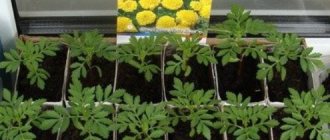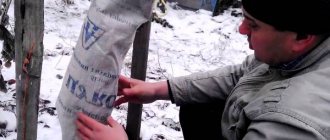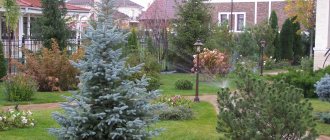Features of growing tomato seedlings at home
Growing tomato seedlings at home is not an easy task, but it is very important. In most regions of our country, tomatoes are grown using the seedling method. Good, high-quality seedlings are the key to the future harvest, so you need to prepare for the process of growing seedlings in advance. What you need to prepare:
- calculate the number of seedlings,
- determine the sowing time,
- prepare the soil mixture,
- seeds,
- container for seedlings.
And it is important to create optimal conditions for growing tomato seedlings. Tomato seedlings in the apartment are dark and hot. And for its normal growth you need a lot of light, sufficient humidity and temperatures that vary depending on the stage of growing seedlings. The features of growing tomato seedlings at home will be discussed further.
Growing tomato seedlings in a greenhouse (with video)
In central Russia, after seedlings have been transplanted several times (up to three times) indoors, at home, they can be grown in a greenhouse on a garden plot, and after that they are planted in a permanent place in a garden bed. A mistake is made by those gardeners who do not grow seedlings in greenhouses. They immediately transfer the plants from the room to the beds. In this case, the results are unsatisfactory. When grown in a greenhouse, tomato seedlings can be kept for 50-60 days, depending on the weather. It should be transplanted from the greenhouse to the garden bed when the air temperature at night reaches 10 °C. This happens by mid-June.
Growing tomato seedlings in a greenhouse in the photo
Seedlings should be transplanted into a greenhouse on a calm day at an air temperature of at least 8 °C. The soil temperature in the greenhouse by this time should be 15–18 °C.
A greenhouse dedicated to growing tomato seedlings for open ground must be prepared with special care. The soil mixture in such a greenhouse should be fertile and loose. It is prepared from 70-80% of well-decomposed peat and 20-30% of loamy turf soil with manure or feces prepared in the summer. For 1 m3 of mixture add 3-5 kg of lime or 10-15 kg of wood ash.
In the fall, the greenhouse is filled with dry leaves to reduce freezing. Now they need to be dug up, disinfected with a 5% formaldehyde solution and filled with manure (2 weeks before planting). The thickness of the layer is no more than 60 cm. A layer of sawdust is poured on top (no thicker than 2 cm). Well-fertilized soil 15 cm thick is placed on the sawdust.
After the manure burns and settles, sprinkle with a 3 mm layer of ash and fill with a layer of soil mixture 15-18 cm thick. Seedlings are planted in it according to a 10x10 cm pattern. When the seedlings take root well in the greenhouse, it is necessary to spray with a 0.1% boric solution acid, and every other day, fertilize: pour 10 liters of chicken manure infusion, 100 g of ash extract, 2.5 g of potassium permanganate, 1.5 g of boric acid into a 12-liter bucket. Before fertilizing, water the plants - 5 liters per 1 m2 with a water temperature of 18 °C. Fertilize between rows at the rate of 100 ml of solution per plant.
During the period of growing seedlings in greenhouses, plants develop in conditions that differ sharply from open ground conditions. This explains the poor survival rate, stunted growth and slow rooting of unhardened seedlings when transplanted into open ground.
Hardening of plants consists of gradually adapting them to open ground conditions by changing the regime in the greenhouse in the last days before planting.
To accustom tomatoes to better lighting, lower temperatures and air humidity, 15 days before planting them in open ground, remove the frames from the greenhouses if the air temperature in the shade is not lower than 10 °C. In the first 2-3 days, the frames are removed for several hours in the afternoon, and then for the whole day. After 4-7 days, the greenhouses are left open at night. In case of freezing, they are immediately covered with frames.
In the last 5-8 days before planting, especially if the weather is warm, the seedlings grow very quickly and sometimes stretch out, which is especially undesirable. You can slow down the growth of seedlings in these last days by stopping watering. During this period, tomatoes are watered only if the plants wilt in the middle of the day.
During the period of hardening off the plants, the soil in the greenhouse must be cut 2-3 times with a knife along the rows and between the plants in the row, in order, as already mentioned, to enhance the formation of roots and create a strong cube of soil near the root system.
Hardened seedlings are more cold and drought resistant. When transplanted, it takes root well and retains leaves and buds.
Watch the video “Growing tomato seedlings in a greenhouse”, which shows all the basic agricultural techniques:
Methods for growing tomato seedlings at home
There are several ways to grow tomato seedlings.
Classic way
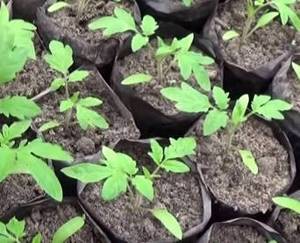
The classic method is growing in seedling boxes or other containers; with this method, seedlings need picking.
When growing tomato seedlings without picking , the seeds are sown in separate glasses. This method allows you to save time on picking, but at the initial stage, when the crops need to be placed closer to the source of light and heating, difficulties arise - it is difficult to place many cups with seedlings.
Growing seedlings in peat tablets
Growing seedlings in special peat tablets allows you to grow tomato seedlings without picking (if 1 seed is sown per tablet). The method is convenient and allows you to avoid wasting time preparing the soil - the tablets consist of a nutrient mixture.
But the volume of the tablet becomes small as the seedlings grow, so the plants will need to be planted in glasses or other containers (to do “transfer of seedlings”). Plants tolerate transplanting tablets with seedlings into the ground very well, since the root system is not injured, which is why this method is popular among gardeners.
Growing seedlings in a "snail"
“snail” has recently become increasingly popular
The method is very convenient and allows you to place a sufficient number of seedlings under the lamp. During the growth of seedlings, its roots are separated by snail coils, so they do not intertwine and the plants tolerate picking from the snail into the ground well. The soil between the turns of the “snail” dries out less, so the seedlings can be watered less often.
It is important to remember that due to the limited amount of soil with a snail pick, there is no need to pull it into separate glasses. Otherwise, the root system will stop developing and the plants will stop growing.
You can read more about this method in the article “Seedlings in a snail diaper, ways to grow at home .
Growing seedlings in a bottle
Another method that is popular among summer residents: growing tomato seedlings without picking in 5 liter bottles . The point of this method is that an improvised greenhouse is made from a plastic bottle - its lid is the cut off upper part of the bottle. The seeds are sown in this greenhouse, and the seedlings are grown until they are planted in the ground.
The positive side of this method is that it saves effort and time due to the fact that there is no need for picking. But there are also tangible negative aspects: it is impossible to grow many seedlings in such a bottle; if you sow them densely, they will be elongated and weak from lack of light. During the development of seedlings, the roots of tomatoes are intertwined; when planting in the ground, you will need to take out the entire contents of the bottle, carefully separate it, and then plant it. Beginners without experience in growing seedlings should probably not start with such experiments.
Methods of growing tomato seedlings by engineer Maslov
In the eighties of the 20th century, engineer Igor Maslov, a Moscow region engineer, developed a method of planting tomatoes lying down, thereby getting many times more tomatoes from one bush. He believes that in order to ensure the filling of a large number of fruits, a powerful root system is needed. And he advises getting it in two ways.
The first is to plant seedlings not vertically, as is usually customary, but lying down. Not only the root, but 2/3 of the stem is placed in a previously prepared furrow, after removing the leaves from this part. Cover with a layer of soil of 10-12 cm. Place the plant strictly from south to north so that as it grows it reaches towards the sun, straightens and grows vertically. On the buried part of the stem, roots quickly form, which are included in the general nutrition system. Moreover, these roots are several times larger in size and efficiency than the main one.
Another method of growing tomato seedlings by engineer Maslov is even simpler and accessible to any gardener. Do not remove the first side shoots - stepchildren - but let them grow subline. Pluck the leaves from them, bend them to the ground and cover with a 10-12 cm layer of soil. The buried stepsons quickly grow. After just a month, it is difficult to distinguish them from the main plant both in height and in the number of ripened fruits. It is characteristic that abundant fruiting begins in close proximity to the soil. Tomato plants are not only not afraid of frequent transplants, but, on the contrary, love them. After each transplant, the plants take root even better, gain strength very quickly, grow well and bear fruit abundantly.
- Author: admin
Rate this article:
- 5
- 4
- 3
- 2
- 1
(11 votes, average: 4.5 out of 5)
Share with your friends!
Dates for planting tomatoes for seedlings
Growing tomato seedlings at home begins with determining the timing of sowing. Question: when to sow tomato seeds for seedlings is often difficult even for experienced gardeners.
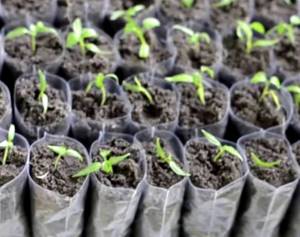
As a rule, many gardeners are in a hurry - in an effort to get the first harvest early, they sow early. But it turns out that with a lack of light, seedlings develop poorly. Weakened plants very often become ill with a very dangerous fungal disease - “black leg”.
When planted in the ground, weak seedlings take a long time to take root and do not immediately begin to grow. Therefore, it is difficult to get an early and decent harvest from such plants. While plants planted at optimal times begin to bear fruit earlier and more abundantly.
For these reasons, determining the date for sowing seeds must be taken very seriously.
The timing of sowing tomato seeds for seedlings depends on several factors, the main ones:
- climatic conditions of the growing region;
- growing conditions – greenhouse, arcs with covering material or film, open ground;
- characteristics of the variety or hybrid of tomatoes - ripening period, type of growth;
- An important factor is the capabilities of the summer resident himself. Not everyone will be able to come and cover plants during a sudden cold snap. In this case, the landing should be planned for the final onset of stable warm weather.
There are several ways to determine the date of sowing seeds for seedlings; a simple and accessible “countdown” method
The essence of the method is that from the approximately planned date of planting the seedlings in the ground, you need to count (in reverse order) the recommended age of the seedlings, the time for seed germination; if the seedlings are grown with picking, then you need to subtract another week.
The recommended age of seedlings is a reference value established by experts.
- for early ripening varieties and hybrids it is 45-55 days,
- mid-season - 55-60 days,
- late ripening 65 -70 days from germination to planting in the ground.
So, for example, if planting seedlings in a greenhouse is planned for approximately mid-April. Then we count from this period the period for growing seedlings - 50 days, the time for emergence of seedlings - 7 days.
It turns out that you need to start growing tomato seedlings at home for the greenhouse on February 18th. If cultivation is planned with picking, then the seeds for seedlings will need to be sown a week earlier.
In order to quickly calculate the date of sowing seeds, including tomatoes, we suggest you use an accessible and understandable service on our website. “Calculator for calculating the date of sowing seeds of main crops”
Selecting soil and containers for seedlings
Even experienced gardeners usually prefer purchased soil for planting tomatoes for seedlings. Beginners should not do it themselves. Any mistake or low-quality component will lead to the death of tomato seedlings.
But even the “correct” substrate must be prepared before placing it in boxes for planting. This is how pathogenic microorganisms and pest larvae that remain in the soil by accident or due to the fault of unscrupulous producers are destroyed:
- Place a bag of substrate in a metal container.
- Boiling water is poured over the wall to prevent it from melting.
- Cover with a lid.
- Allow to cool naturally.
If the seedlings will be planted, it is convenient to sow tomato seeds in low wooden boxes. You can use plastic ones, but they need to be covered with thick polyethylene with many holes made to drain excess water.
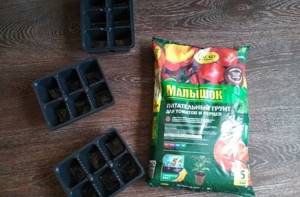
When you need very few tomato seedlings, use low, wide flower pots for planting. Again, drainage holes are a must.
With the seedless method, tomato seeds are planted immediately in individual containers. You can use special pallets, peat tablets, plastic egg trays, cups up to 200 ml.
If you immediately take a large container for planting, the tomatoes will feel uncomfortable until they entwine their roots around the entire earthen ball. And this will require additional time.
New tomato containers can simply be washed before filling with soil. Used ones are doused with boiling water, soaked in potassium permanganate or sterilized in any convenient way.
Preparing soil for tomato seedlings
The soil for tomato seedlings should be loose, well permeable to moisture, but at the same time sufficiently moisture-absorbing. In this type of soil, when watering, moisture is quickly absorbed, and its excess flows out without delay. The reaction (acidity) of the soil environment should be close to neutral.
Beginner gardeners mistakenly think that seedlings need rich and nutritious soil. This soil is good for already mature plants. In overly nutritious soil, seed germination is delayed and seedling growth slows down.
A ready-made mixture for growing tomato seedlings can be found at any garden or hardware store. It is important not to save money and choose trusted manufacturers. If you prefer to prepare your own mixture for growing tomato seedlings, you can prepare this
Composition of soil for tomato seedlings
1 hour leaf humus, 1 tsp. turf soil, 0.5 hours. peat 0.5 parts of river sand or washed construction sand, 1 cup of wood ash per bucket of the mixture.
To avoid the death of young plants from the disease “root collar rot”, or simply “black leg”, it is necessary to disinfect the soil.
Disinfection of soil mixture
Disinfection can be carried out using several methods:
- Freezing at low negative temperatures. The process can be repeated several times, taking the prepared soil out into the cold for several days, keeping it at room conditions for 4-5 days, then again in the cold and again in the heat.
- Steam in a colander over a pan of boiling water for 6-8 minutes. The method is effective, but quite troublesome.
- Etching with various preparations - a pink solution of “potassium permanganate”, “Fitosporin”, “Trichodermin” - these are biological products, with the means “Maxim summer resident”
How to protect tomato seedlings from diseases
No matter how you grow seedlings, they can get sick and therefore it is important to protect young plants from such a scourge. There are different diseases - fungal, viral, bacterial, non-infectious. There can be many reasons - diseased seeds, soil pests, improper care, lack of mineral fertilizers or their improper use and other reasons.
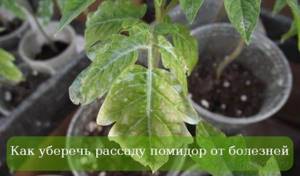
How to recognize a particular disease and how to treat it is a separate and large topic; today we will talk not about the diseases themselves, but about their prevention. Although they were already mentioned in the article, in conclusion I decided to repeat them.
To grow strong and healthy tomato seedlings at home you need:
- carry out pre-sowing seed treatment;
- plant seedlings in high-quality, disinfected soil;
- avoid overcrowding of seedlings by following the planting pattern;
- observe the temperature regime, monitor the lighting of plants and watering;
- discard sick and weak plants;
- carry out the procedure of hardening seedlings.
Growing tomato seedlings yourself is, of course, troublesome, but exciting. Add desire and patience to all the above recommendations and you will succeed, and as a reward you will have an excellent harvest of your favorite vegetables in the summer.
Treatment of tomato seeds before planting seedlings
The purpose of pre-sowing treatment is to free the seeds from pathogens, increase their viability and accelerate germination.
The germination of tomato seeds lasts for at least 8 years, so if the seeds are not expired, they do not need special manipulations to increase germination.
The most necessary treatment is seed disinfection. Experts say that 80% of diseases of vegetable crops, including tomatoes, are transmitted through seeds. Therefore, to prevent the occurrence and development of diseases, seeds must be disinfected.
Disinfection is not carried out only on seeds that have already been treated by the manufacturer (usually the manufacturer writes about this on the bag of seeds) or if the seeds are covered with a special coating - they are coated.
One of the reliable and proven methods of disinfecting seeds at home is heat treatment. When heated, almost 100% of plant pathogens are destroyed.
At home, it is convenient to carry out heat treatment with hot water:
Tomato seeds are placed in bags (fabric or gauze) and heated for 30 minutes in a thermos with hot water at a temperature of +50...+52°C, and then cooled for 2 - 3 minutes in cold water.
After treatment, the seeds can be sown immediately in the ground, or you can soak them before sowing in a solution of biostimulants - “Zircon”, “Epin”, etc. Treatment with stimulants promotes seed germination, increases the resistance of young plants to diseases, and reduces the sensitivity of seedlings to unfavorable growing conditions.
More information on the use of plant growth regulators (Epin, Zircon, Tsitovit) can be found in the article Plant Growth Regulators NEST M
How to properly care for tomato seedlings?
Watering
It is worth moistening the soil as needed. Excessive watering can cause seedling roots to rot. It is not recommended to water the soil before the first true leaves appear, but this is provided that the prepared soil retains moisture well. After this, the soil is watered once a week, and after 5 leaves appear - once every 3-4 days.
Watering is carried out with settled water at a temperature higher than room temperature by 1-2 degrees. Do not forget to regularly ventilate the room where the seedlings are grown.
Lighting
Tomatoes love good lighting. Otherwise, the seedlings will be elongated and weak. The seedlings should remain in a lighted place for at least 12 hours. Therefore, stock up on devices for additional lighting of seedlings. For example, a fluorescent lamp installed at a height of 22-25 cm from the seedlings is suitable.
Top dressing
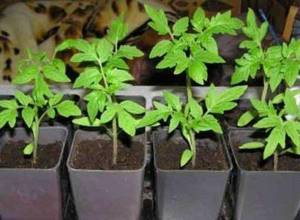
However, you should pay attention to the appearance of the seedlings: bright green foliage and a strong stem indicate the normal condition of the plant, which does not need feeding. Otherwise, adding fertilizer won't hurt.
The soil should be fertilized 10 days after picking. Special fertilizer can be purchased at the store. After fertilizing the soil, it should be watered and loosened.
Picking
After 2-3 leaf blades appear, the sprouts should be planted in separate containers with a volume of at least 0.5 liters. Cups with drainage in the form of holes in the bottom are perfect for picking. Thanks to this procedure, the seedlings harden and become stronger, and elongated seedlings reduce their growth and become more squat. Such seedlings are planted in the ground up to the cotyledon leaves.
The picking process is simple.
- To begin, water the soil with the seedlings generously.
- Pour soil into the prepared containers, compact it and make a depression in the center.
- We carefully remove the seedling from the soil, be sure to pinch the main root by a third.
- Then we lower the seedling into the hole and cover it with soil.
- The air temperature is raised by 3-4 degrees, and the lighting is slightly reduced. The seedlings will remain in such conditions for several days, then they are returned to normal conditions.
Many gardeners enjoy growing seedlings at home. This process is simple, and vegetables grown with your own hands from seed to fruit are more pleasing in taste and appearance at the end of the season than just store-bought fruits.
Planting tomato seeds for seedlings
How to sow tomatoes for seedlings at home:
Tomato seeds can be pre-germinated between two layers of damp cloth or cotton pad at a temperature of 25-28°C. This method allows you to immediately reject non-germinating and weakened seeds.
Then carefully transfer the hatched seeds with tweezers into the seedling boxes.
You need to sow the seeds sparingly, otherwise the seedlings will interfere with each other’s development and will not receive enough light and nutrients. Too frequent sowing also contributes to the development of the fungal disease “black leg of seedlings”.
It is convenient to make grooves for seeds using the edge of a ruler.
Seed sowing scheme: the distance between rows of crops is 4-5 cm, between the plants themselves 1-2 cm.
The sowing depth of the seeds is about 0.5-1 cm. There is no need to sow the seeds deeply, otherwise the seedlings will appear unevenly.
After sowing, containers with seeds should be carefully moistened with warm water. The soil should be moist, but not soggy. For watering, it is better to use a spray bottle; you can gently wet the soil with it without over-flooding.
After sowing, the seedling containers are covered with a plastic bag and put in a warm place.
Video
The entire process of preparing for sowing and directly sowing tomato seeds is shown in the video in a very accessible and understandable way, we suggest you familiarize yourself with it
When to plant tomatoes for seedlings
The time for sowing tomato seeds directly depends on the variety you have chosen. These varieties are early ripening (early ripening, early, ultra-early ripening), mid-ripening (mid-early, medium) and late ripening (late). Often, gardeners combine ultra-early and early varieties with medium ones in order to receive fruit continuously throughout the summer.

Knowing the timing of the beginning of fruiting of a particular variety, you can approximately calculate the sowing time. Often, manufacturers indicate approximate sowing time frames on seed packaging, and we, on our part, must adjust them to suit our conditions.
It is also important to note for yourself whether seedlings are being prepared for a greenhouse or open ground. There is no point in sowing early seeds in February if the greenhouse in your region will only become available at the end of April, or even the beginning of May.
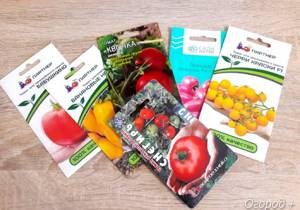
Let's try to calculate using an example. Let's assume that we have a mid-season variety whose fruiting begins 105-115 days after sowing. Let's assume that we want to harvest around July 10th. We count down 110 days, add another 10 days for the sowing itself, waiting for germination and for the adaptation of the tomato in the soil after transplantation. We get only 120 days. This means that sowing must be done on March 10th.
In the same way, the sowing date of early and late varieties is calculated. When choosing seeds, also pay attention to the harvest date. It is advisable that the seeds are no older than 2 years. After this period, germination will deteriorate every year.
Conditions for growing tomato seedlings
After sowing, tomato seeds require warmth, moderately moist soil and regular ventilation to germinate.
Temperature for tomato seedlings
At different stages of growing tomato seedlings, different air temperatures are needed.
Seeds need a temperature of +22…+25°C (at least 20°C) to germinate. At low soil temperatures, especially if it is too wet, the seeds may rot.
When the seedlings begin to appear en masse, the temperature should be reduced to +14...+16°C for about 5-7 days. This technique will allow you to slightly slow down the growth of seedlings so that their root system becomes stronger.
When the young seedlings get a little stronger, the temperature is raised to +18...+22°C during the day, and +14...+16°C at night, no more, otherwise the seedlings will begin to stretch.
Very often, summer residents have a question: how can you regulate the air temperature within one room. To maintain different temperatures for growing seedlings, containers with seedlings can be moved closer to the window frame or, conversely, to the radiator.
Lighting tomato seedlings
While there are no shoots, light is not needed, so the seeds can be kept in the dark near the battery.
As soon as the first loops of seedlings appear, the seedlings must be placed in a well-lit place. During this period, the development program of the entire plant begins, including productivity.
Plants need to be provided with at least 11-13 hours of daylight per day. This is approximately 2-3 hours in the morning and evening.
Additional illumination of seedlings at home should be continued until the seedlings are planted in the ground, reducing the time the lamps are turned on as daylight hours increase.
How do you know if you need to turn on additional lighting?
It is generally accepted among experts that if, when the lamp is turned on, practically no changes in illumination are detected, then it means that the backlight does not need to be turned on. If the difference is felt, additional lighting is needed.
The issue of additional lighting for seedlings is discussed in detail in the article
Lighting for seedlings [why, methods and recommendations]
Watering tomato seedlings
The soil in the seedling containers should be slightly moist, otherwise the seeds will rot. It is better not to water the seedlings, but to spray them with a spray bottle, keeping the soil substrate moist.
Water for irrigation must be at room temperature. When watering with tap water, it must be allowed to settle so that the chlorine evaporates. Experts do not recommend watering tomato seedlings at night, only during the day.
To prevent “black leg” and other fungal diseases, it is very good to use the biological product “Fitosporin” when watering approximately once every 10 days (according to the instructions).
The issue of watering tomato seedlings is covered in more detail in the article
Caring for tomato seedlings after germination
Feeding tomato seedlings
It is difficult to grow good seedlings without the use of fertilizers. The technology for growing tomato seedlings requires regular feeding, but excess fertilizer will not benefit the seedlings.
Most often, seedlings planted in poor-quality soil, or “overexposed” (sown too early) seedlings that no longer have enough soil volume for growing, experience a lack of nutrients.
If the seeds are sown in high-quality soil, then you can use fertilizers for feeding until the seedlings begin to develop real leaves.
Fertilizing is usually carried out every 10 days with any complex fertilizer for seedlings.
Fertilizers must be used according to instructions; the concentration cannot be increased, otherwise you can burn the root system. If necessary, it is better to feed the seedlings more often, but with a weaker fertilizer solution.
According to the rules, the soil needs to be moistened and then fertilized. Immediately after picking, while the root system is being restored, the seedlings are not fed.
TOMATOES FROM A TO Z: variety selection, sowing, seedlings, planting
Today we will talk to you about growing tomatoes from A to Z. Let's start with choosing varieties. What to choose, a linear variety or a hybrid variety? It is not difficult to choose between these two types of varieties. Hybrid varieties are designated on packages with the letter F1. If your conditions are ideal for growing tomatoes, if you can provide them with the best conditions every day, then choose hybrid varieties, or, as people call them, hybrids.
If you have average conditions, you are not sure that you can fully provide the tomatoes with everything they need, if you visit the site intermittently, not every day, on weekends - give preference to linear-type varieties that do not have the F1 designation. To be sure that you grow healthy seedlings, be sure to :
- seed disinfection,
- colonization of seeds with competitive microflora,
- disinfection of soil for growing seedlings.
To disinfect seeds, choose the effective method that suits you best - it can be chlorhexidine, it can be methylene blue, brilliant green, garlic infusion or aloe juice. In order to neutralize the soil , use only steaming or calcination. Don't believe in potassium permanganate or formiode or anything like that. It's ineffective. In order to provide the seeds with competitive microflora that will fight various pathogens, populate them with phytosporin or other preparations containing Bacillus subtilis. If you have preparations containing Trichoderma on hand, they will also work, but be careful - when mixing preparations containing Bacillus subtilis and Trichoderma, they are not always compatible.
Be sure to carry out blackleg prevention . In order to prevent blackleg, seedlings need to be warm, light and dry. The black leg lives where cold air blows from the windowsill, where the soil is waterlogged and there is not enough heat and light.
If your seedlings are stretched out, this means that they are too warm and have too little light. Adjust these settings. Under no circumstances feed with humates , as some advise - this is very bad. Only light, warmth and amount of moisture.
Pick tomatoes correctly . In order to pick tomatoes you will need the right utensils. These could be pots, they could be spunbond cups. But remember that seedlings at the beginning of their growth and development like small cup sizes. She prefers to sit in a small container so that the roots have time to grow into a root ball. It is better to make several transplants, first into a small volume, and then into a larger volume. At the same time, you will deepen the stem, which will allow an additional root system to develop, and excessively elongated sprouts will be able to reduce their length due to deepening. Beware of “snails” made from plastic that is not intended for contact with water. Plastic can release significant amounts of toxic substances into both water and soil. We are already surrounded by too many toxic substances to saturate our plants with it.
For reliable survival of seedlings in open ground, be sure to harden them - this is very important ! Hardening off seedlings and proper feeding, that is, providing all the necessary nutrients before the stress of plant transplantation, is the key to good survival and normal growth of established seedlings.
But before you plant the seedlings in the greenhouse, carry out disinfection . The use of peroxide bleaches, such as persol, bos and others, which contain perborates and percarbonates, is an excellent alternative to various disinfectants. They are cheap, they are effective and they are completely environmentally friendly.
Before planting seedlings, be sure to fill the soil with complex fertilizer - this will allow the seedlings to eat properly, harmoniously, increasing the necessary vegetative mass of the tomato; the tomato should be in the vegetative phase before flowering begins.
In order for the soil to get rid of phytopathogens , additionally add trichodermin or phytosporin when digging. Against harmful insects, add metarizium (mushroom), for example, as part of the drug metarizin. And against nematodes, use Actofit, and also during the growing season, make an infusion of marigolds, dig up marigolds, mulch with marigolds, because the nematode really does not like these plants.
To prevent late blight, isolate the soil from plants. You can lay spunbond and also apply various types of mulching. I prefer spunbond. You can plant seedlings in holes or trenches, on a side. It all depends on your local conditions - if your soils are light and easily permeable, the root system has a chance to grow deep and reach the moist layer. In this case, plant the seedlings in a deep place, but remember that deepening the seedlings when planting in a permanent place will delay the onset of fruiting by 10 or even more days (up to 2 weeks). If you place seedlings in trenches on their sides, this must be done if your soil is well-hydrated, heavy, and clayey. There is no hope that the roots will grow deep enough, because such soils at depth are usually cold, and your tomato root system will form rather superficially. The watering regime also depends on this. If you put the plants on a barrel, you need to do top watering, and be sure to protect your plants from soil splashes, because they, too, are sources of various tomato diseases. If you planted tomatoes in depth and hope for deep development of the root system, in this case it is necessary to organize bottom watering. For example, through water bottles or some other liquids - this is very easy to do.
To grow a large crop of tomatoes in its vegetative phase, it must build up a large vegetative mass, which will subsequently feed a large harvest of fruit. In this case, after planting the seedlings, start feeding them mainly with nitrogen fertilizers. This will allow you to build up a strong vegetative mass. When the first cluster appears, stop fertilizing with nitrogen almost completely. Increase the doses of fertilizers, increase the concentration of the solution and switch the fertilizer to a phosphorus-potassium base. This will contribute to the transfer of the tomato into the generative phase and will not allow the plants to fatten - they will predominantly bloom and bear fruit.
For better tomato set, use boric acid correctly and important agricultural techniques to increase the number of ovaries. This includes ventilation and other agricultural practices.
To prevent and control late blight during flowering and fruit set, use biological products based on Bacillus subtilis and Trichoderma. If these drugs are not available to you, or the risk of late blight is high, also use the method of combating it with curcumin, that is, whole turmeric. Make a vodka tincture, dilute, dilute and process. You can use all three methods of combating late blight - turmeric, phytosporin, or another drug based on Bacillus subtilis, or Trichoderma, alternating them every 10-14 days.
In order to improve the taste of tomatoes , apply phosphorus and potassium supplements. Continue these feedings until the end of the tomato growing season and the last fruits are harvested. Regular spraying with succinic acid will significantly improve the taste of tomatoes. But when feeding, do not forget about small doses of nitrogen - this is important, and also, look carefully, do not block one battery with another battery.
Make harmonious feedings. Use our calculator to calculate the number of doses of fertilizers. In addition, use not very concentrated solutions, both for spraying and watering. Proper watering and fertilizing will prevent plant burns from forming and will harmoniously nourish your plants until the end of the tomato growing season.
In case of drought , use not just watering, but watering with the addition of acetic acid - this will not only make phosphates more available to your plants, but will also saturate the plants with energy molecules that will support them during an unfavorable period of drought.
For blossom end rot, use nitrogen-free fertilizers with fast calcium. Use nitrogen only in ammonium form, that is, only ammonium fertilizers such as ammonium sulfate, this will be best for providing plants with both sulfur and nitrogen during the fruiting period.
Water tomatoes correctly so as not to cause cracking of the fruits or cause the formation of steam and droplets. In case you live in a hot climate, saturate your tomato plants with moisture in the evening, because this is when they need moisture the most after a hot day. If the temperatures in your greenhouse are low and there is no sweltering heat, in this case you can also water the tomatoes during the day. But remember, before closing the greenhouse at night, you must ventilate it properly, otherwise droplets will form, which will cause a sharp increase in the risk of late blight and mass plant damage. To reduce drips and steam, hang small bags filled with silica gel or cat litter in the greenhouse - this will help cope with this problem.
To speed up the ripening of fruits , especially if there is a risk of late blight, make cuts on the stem at the base of the tomato stem, and also use other methods to speed up the ripening of fruit filling.
Well, growing a tomato is not difficult and very exciting. Our advice on our channel will always help you do this correctly, efficiently and reliably. With this I say goodbye to you, all the best!
Picking tomato seedlings
Picking is a very important process when growing tomato seedlings. It is necessary for the seedlings to develop normally - to receive enough lighting, nutrients and moisture.
The timing of the picking is the appearance of 2–4 true leaves on the seedlings. At this time, the root system is already quite well formed and the plants take root easily.
It is believed that for short and medium-sized tomatoes, one pick is enough. And tall tomato varieties will have to be replanted 2 times as the plants grow.
Basic picking rules:
- The seedlings need to be watered abundantly in advance (12–24 hours in advance). Do not water the seedlings immediately before the picking procedure - the root system of the seedlings can be damaged when digging them out of wet, heavy soil;
- the seating capacity is usually used 1.5 times larger than the previous one;
- after picking, special, gentle conditions are created for the plants; inexperienced gardeners’ seedlings often die at this time.
After picking, the seedlings need moderate watering, always with warm water, otherwise the plants will begin to be affected by the “black leg”.
In order for the seedlings to take root as quickly as possible, they need to be placed in a warm place (+20...+ 25°C). If it is sunny days, it should never be placed in a sunny place. While plants are stressed after transplanting, they should be kept in diffused light. To create greenhouse conditions, plants can be covered with a piece of spunbond or film.
When the seedlings get a little stronger, they can be placed at a temperature of +18...+20°C and up to +15...+16°C at night, and after 10 days they can be fertilized with fertilizers.
Planting tomato seedlings in a permanent place
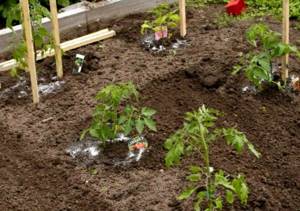
After 1.5 months, home seedlings begin to force flower clusters. As soon as they are noticed, it means that after 1.5-2 weeks it is necessary to plant them in a permanent place.
Overexposure to seedlings will turn them into undergrowth. Plants that have had time to bloom usually lose color and stop growing. However, this problem is partially solved by removing the first brush, but there will no longer be a full harvest.
To the greenhouse
The grown seedlings are planted in an unheated greenhouse in the first half of May, focusing on weather conditions.
Tall tomatoes are planted in one row or staggered, at a distance of 50 cm. After planting, the plant is not watered for 10-12 days.
After planting, the crops are tied with twine to a wire stretched in advance at a height of 2 meters. The twine is carried under the 2nd sheet, and then twisted weekly, without pulling it too tight.
After watering with warm water, it is advisable to mulch the plantings.
In open ground
Tomatoes are planted in open beds in warm regions in May, when the daytime temperature reaches approximately +22ºС. And in colder regions, tomatoes are planted even in June. The main thing is that at night the readings do not drop below +15ºС. At cold temperatures at night, you can additionally install arcs and cover the seedlings with covering material.
Place the seedlings in a sunny location, protected from cold winds.
Damp areas with close groundwater are considered unfavorable places for planting tomatoes.
The soil is preferably loamy with the addition of mineral and organic fertilizers.
Plants are placed at a distance of 40 cm from one another. It is better to plant on a cloudy, windless day. When planting, the stem is buried 2-3 centimeters. Over time, additional roots form on it. Plantings are watered with warm water and mulched.
Hardening off tomato seedlings
When growing tomato seedlings at home, the plants must be prepared for changing growing conditions. Seedlings of even the most unpretentious varieties grown indoors will be pampered, so they need to be gradually accustomed to planting in harsher conditions.
Experts recommend this hardening regime: approximately 10 days before planting, reduce the night temperature to +12...+14°C. Usually, as the temperature decreases, watering of seedlings is also reduced - the amount is reduced.
A correctly carried out procedure for hardening off seedlings helps the plants to more easily tolerate the stress of transplantation and begin to grow faster.
Common mistakes

When growing seedlings, the following mistakes are often made:
- The wrong variety of tomatoes is selected. There is no need to rely on beautiful descriptions on a packet of seeds or the manufacturer’s website. Use varieties that are suitable for your region.
- A summer resident plants unprepared seeds . Disinfection, bubbling, and soaking are important procedures that help the summer resident get healthy seedlings. There is no need to ignore them.
- Failure to comply with care rules. The two most common mistakes with this plan are overwatering and not enough light. As a result, the plants either begin to rot or stretch out.
- No picking. Plants need space to grow. Therefore, tomatoes from a common box to a specific one must be planted in separate containers.
- No hardening. Over the months spent at home, the seedlings get used to the mild indoor climate and regular care. If you plant them in open ground without hardening off, many plants will not tolerate such stress and will die. To prevent this from happening a few days before transplanting, harden the seedlings.
Problems of growing tomato seedlings
Tomato seeds do not germinate
One of the common problems when growing seedlings is that tomato seeds do not germinate. If the seeds are not expired, then most likely the recommended growing conditions have been violated - the soil is too wet and/or it is at a very low temperature, under such conditions the seed embryo dies. Therefore, it is extremely important to follow recommendations for maintaining the conditions for growing seedlings.
The reasons for poor germination of tomato seeds are described in more detail in the article Why poor germination of tomato seeds [main reasons] . Also, seeds may not germinate due to the appearance of mold on the surface of the soil substrate. Molds germinate more actively than sown seeds and the seedlings die.
To prevent the appearance of mold on seedlings, it is imperative to carry out preventive measures. The reasons for the appearance of mold fungi and methods of combating this problem are described in more detail in the article Mold on seedlings, what to do? .
Black leg of tomato seedlings
This is a fungal disease that occurs in wet and cold soil. The loss of seedlings due to blackleg damage can be significant, which means lost time and costs for new seeds.
Root collar rot of seedlings is easier to prevent than to cope with. Therefore, prevention is very important. To prevent the disease it is necessary:
- mandatory soil disinfection;
- compliance with recommendations for maintaining temperature and watering schedule;
- use drugs for prevention.
Modern biological products - “Fitosporin”, “Trichodermin”, “Glyokladin”, etc. are quite effective against pathogens of fungal plant diseases, in particular “blackleg”.
Stretched tomato seedlings
Another very common problem is that tomato seedlings stretch out. This occurs due to lack of light and non-compliance with temperature conditions.
Low light and high temperature are the main factors in causing this problem.
The answer to the question “tomato seedlings have stretched out, what should I do?” there will be 2 options :
- providing additional lighting for seedlings
- or a significant decrease in temperature.
In this case, the growth of seedlings will slow down, but in this case, there is no point in sowing seeds early for seedlings. That’s why experienced gardeners say that there is no need to sow seedlings too early.
In both cases, treatment of seedlings with growth regulators “Athlete”, “Koreasty”, etc. is effective. These drugs help strengthen the root system of seedlings and the formation of compact and stocky plants.
Read about all the reasons and methods of combating the pulling of seedlings in the article
If the seedlings stretch out, what should I do?.
Step-by-step instructions for sowing tomato seeds
Once you have prepared the soil mixture and seeds, you can begin sowing. The procedure is actually simple and can be divided into seven steps. The main thing is to follow the instructions.
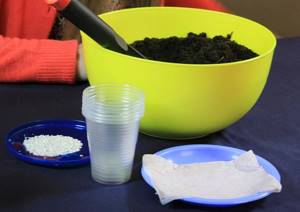
Planting tomato seeds for seedlings
Step 1: Fill plastic cups with drainage. This will improve air exchange. Small pebbles or eggshells can act as drainage material.
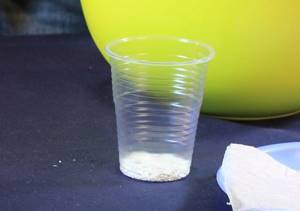
Drainage made from crushed eggshells
Step 2: Place the soil in a container and water thoroughly. The water must be warm.
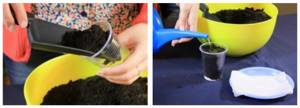
Backfilling and watering the soil mixture
Step 3. The depth of sowing the seeds should not be more than 2 cm. To protect yourself from mistakes, it is advisable to first make small holes in the soil and only then place the tomato seeds there.
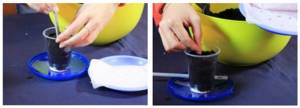
Tomato seeds are usually sown to a depth of 1-2 cm, so you first need to make shallow holes in the ground and then lower the seeds into them
Step 4: Use a spray bottle to moisten the soil. This is done to prevent the seeds from going deep into the ground.

Soil moisture
Step 5. After sowing, you need to put the cups in a warm room. Before this, they need to be covered with film.

Cups are covered with film
Step 6. Job done. Now you just need to wait for the shoots. As a rule, they can appear within 5-7 days.

Tomato seedlings shoots
Step 7. Expose the cups with seedlings to the light after the shoots appear.
